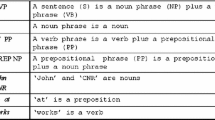Abstract
This paper proposes a new approach to simulating language evolution; it expands on the original work done by Lee and Zadeh on Fuzzy Grammars and introduces a Type-2 Fuzzy Grammar. Ants in an Ant Colony Optimization algorithm are given the ability of embedding a message on the pheromone using a Type-2 Fuzzy Grammar. These ants are able to gradually adopt a foreign language by adjusting the grades of membership of their grammar. Results that show the effect of uncertainty in a language are given.
Access this chapter
Tax calculation will be finalised at checkout
Purchases are for personal use only
Preview
Unable to display preview. Download preview PDF.
Similar content being viewed by others
References
Alvarado-Magaña, J.P., Rodríguez-Díaz, A., Castro, J.R., Castillo, O.: Simulation of Language Evolution using Fuzzy Grammars. In: 31st Annual NAFIPS Meeting (2012)
De Boer, B.: Emergent Vowel Systems in a Population of Agents. In: Proceedings of ECAL 1997 (1997)
Briscoe, T.: Language Acquisition: The Bioprogram Hypothesis and the Baldwin Effect. MS, Computer Laboratory, University of Cambridge (1997)
Castro, J.R., Castillo, O., Melin, P., Rodríguez-Díaz, A.: A hybrid learning algorithm for a class of interval type-2 fuzzy neural networks. Inf. Sci. 179(13), 2175–2193 (2009)
Castillo, O., Melin, P., Pedrycz, W.: Design of interval type-2 fuzzy models through optimal granularity allocation. Appl. Soft Comput. 11(8), 5590–5601 (2011)
Chiswick, B.R., Miller, P.W.: A Model of Destination-Language Acquisition: Application to Male Immigrants in Canada. Demography 38(3) (2001)
Chomsky, N.: Government and Binding, Foris, Dordrech (1981)
Cocke, J., Schwartz, J.T.: Programming Languages and Their Compilers. Courant Institute of Mathematical Sciences, New York (1970)
Deacon, T.: The Symbolic Species. Penguin, London (1997)
Dorigo, M., Di Caro, G.: The Ant Colony Optimization Meta-Heuristic. In: New Ideas in Optimization. McGraw-Hill (1999)
Dustmann, C., Fabbri, F.: Language Proficiency and Labour Market Performance of Immigrants in the UK. The Economic Journal 113(489) (2003)
Fernald, A., Simon, T.: Expanded intonation contours in mother’s speech to newborns. Developmental Psychology 20, 104–113 (1984)
Hashimoto, T., Ikegami, T.: Emergence of net-grammar in communicating agents. BioSystems 38, 1–14 (1998)
Hutchins, E., Hazelhurst, B.: How to invent a lexicon. The development of shared symbols in interaction. In: Artificial Societies: The Computer Simulation of Social Life. UCL Press, London
Jim, K.-C., Lee Giles, C.: Talking Helps: Evolving Communicating Agents for the Predator-Prey Pursuit Problem. Artificial Life 6(3), 237–254 (2000)
Kasami, T.: An efficient recognition and syntax analysis algorithm for context-free languages. Technical Report AFCRL-65-758, Air Force Cambridge Research Laboratory, Bedford, Massachusetts (1965)
Kegl, J.: Conference Report: Linguistic Society of America Meeting. Signpost 7(1) (1994)
Kegl, J.: The Nicaraguan Sign Language Project: An Overview. Signpost 7(1) (1994)
Lee, E.T., Zadeh, L.A.: Note on fuzzy languages. Information Sciences 1, 421–434 (1969)
Mendel, J.M.: Uncertain Rule-Based Fuzzy Logic Systems: Introduction and New Directions. Prentice-Hall, Upper Saddle River (2001)
Perfors, A.: Simulated Evolution of Language. Journal of Artificial Societies and Social Simulation 5(2) (2000)
Pinker, S., Bloom, P.: Natural language and natural selection. Behavioural and Brain Sciences 13, 707–784 (1990)
Pinker, S.: The Language Instinct. William Morrow and Company (1994)
Pinker, S.: Why the child holded the baby rabbits: A case study in language acquisition. In: Language: An invitation to Cognitive Science, 2nd edn., vol. 1, pp. 107–133. MIT Press, Cambridge (1995)
Senghas, A.: The Development of Nicaraguan Sign Language via the Language Acquisition Process. In: BUCLD 19: Proceedings of the 19th Annual Boston University Conference on Language Development. Boston Cascadilla Press (1995)
Shipley, E., Kuhn, I.: A constraint on comparisons: equally detailed alternatives. Journal of Experimental Child Psychology 35, 195–222 (1983)
Tomasello, M.: First words: A case study of early grammatical development. Cambridge University Press, Cambridge (1992)
Veglery, A.: Differential Social Integration among First Generation Greeks in New York. International Migration Review 22(4) (1988)
Younger, D.H.: Recognition and parsing of context-free languages in time n3. Information and Control 10(2), 372–375 (1967)
Zadeh, L.A.: The Concept of a Linguistic Variable and Its Application to Approximate Reasoning. Information Sciences 8, 199–249 (1975)
Author information
Authors and Affiliations
Editor information
Editors and Affiliations
Rights and permissions
Copyright information
© 2013 Springer-Verlag Berlin Heidelberg
About this chapter
Cite this chapter
Alvarado-Magaña, J.P., Rodríguez-Díaz, A., Castro, J.R., Castillo, O. (2013). Type-2 Fuzzy Logic Grammars in Language Evolution. In: Melin, P., Castillo, O. (eds) Soft Computing Applications in Optimization, Control, and Recognition. Studies in Fuzziness and Soft Computing, vol 294. Springer, Berlin, Heidelberg. https://doi.org/10.1007/978-3-642-35323-9_11
Download citation
DOI: https://doi.org/10.1007/978-3-642-35323-9_11
Publisher Name: Springer, Berlin, Heidelberg
Print ISBN: 978-3-642-35322-2
Online ISBN: 978-3-642-35323-9
eBook Packages: EngineeringEngineering (R0)




